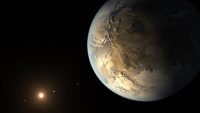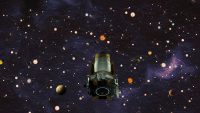This illustration depicts one possible appearance of the planet Kepler-452b, the first near-Earth-size world to be found in the habitable zone of a star similar to our Sun. (NASA Ames/JPL-Caltech/T. Pyle)
Home This illustration depicts one possible appearance of the planet Kepler-452b, the first near-Earth-size world to be found in the habitable zone of a star similar to our Sun. (NASA Ames/JPL-Caltech/T. Pyle) This illustration depicts one possible appearance of the planet Kepler-452b, the first near-Earth-size world to be found in the habitable zone of a star similar to our Sun. (NASA Ames/JPL-Caltech/T. Pyle)




